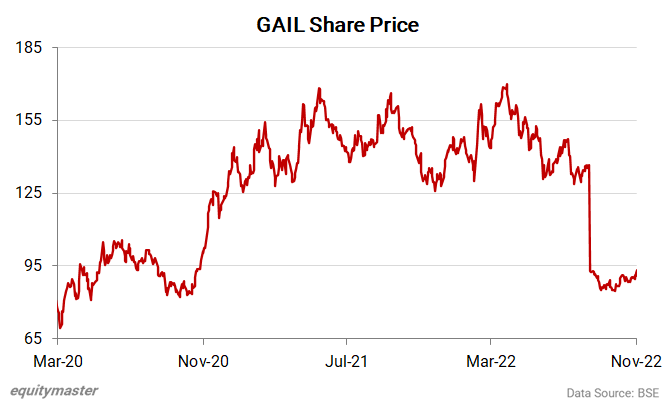- Home
- Views On News
- Dec 8, 2022 - Top 5 Oil Companies in India by Growth
Top 5 Oil Companies in India by Growth

India is the third largest consumer of oil in the world. With rising demand, it wouldn't be a surprise if India took the first spot in the future.
The government of India is taking steps to fulfil this rising demand. It is encouraging domestic and international companies to invest in the sector by easing policies.
It is also planning to double its oil refining capacity to 450-500 m tonnes by 2030. These initiatives are expected to give a boost to oil stocks.
Here are five oil companies you should add to you watchlist. They are ranked by their sales growth in the last five years.
#1 Gujarat State Petronet
The first company on our list is Gujarat State Petronet, a subsidiary of Gujarat State Petroleum Corporation, one of the country's leading oil & gas exploration companies.
The company's primary business is the transmission and distribution of natural gas.
It owns and operates 2,715 km of natural gas pipelines in the state of Gujarat, making the company the second-largest player in the industry.
The company also generates electricity through windmills and has an installed capacity of 52.50 megawatts (MW).
Gujarat State Petronet's revenue has grown at a compound annual growth rate (CAGR) of 20% in the last five years. The net profit also grew by 18% (CAGR) during the same time.
With Gujarat being the highest natural gas consuming state (almost 40% of the domestic consumption), there is a steady utilisation of the company's pipelines.
The company also enters into gas transmission agreements with its customers for tenures ranging from one month to fifteen years.
In the financial year 2022, the company successfully connected twelve customer locations and continues developing an additional pipeline network in Gujarat.
For this, the company has planned a significant capex for the next five years and is awaiting approval from the authorities.
It plans to fund this capex largely through internal accruals retaining its debt-free status. The company has sufficient liquidity and an interest coverage ratio of 27x in the financial year 2022.
Its return on equity (RoE) and return on capital employed (RoCE) is 27.5% and 36.3%, respectively.
The shares of the company have also soared more than 70% since March 2020.

Going forward Gujarat State Petronet plans to expand to other states covering the western and northern regions of India. This will help the company capitalise on India's growing demand for natural gas.
To know more about Gujarat State Petronet, checkout its factsheet and latest quarterly results.
#2 Oil India
Second on our list is Oil India, a Navaratna company under the ownership of the Ministry of Petroleum and Natural Gas.
Oil India started as an exploration and production (E&P) company and has gradually diversified to increase its presence across the entire hydrocarbon value chain.
It is a fully integrated oil and natural gas company engaged in the exploration, developing, producing and transporting of crude oil, natural gas, and liquified petroleum gas (LPG).
The company also generates electricity through solar, wind, and green hydrogen sources.
Over the years, the company's continued capex in greenfield and brownfield projects has helped the company grow and become the country's second-largest oil and natural gas company.
Steady growth in volumes has helped the company grow its revenue at a CAGR of 14% in the last five years. The net profit also grew by 28% CAGR during the same time.
In the financial year 2022, Oil India contributed 10% of the country's crude oil production. Its RoE and RoCE are 21.6% and 20.9%, respectively.
The company's debt-to-equity ratio for the financial year 2022 is 0.5x, and it plans to maintain it despite planning a capex of Rs 43 billion (bn) for the financial year 2023.
The shares of Oil India have also zoomed more than 200% since March 2020.

Even with debt on its books, the company has paid dividends consistently since 2010.
Going forward, it aims to become an international E&P player with operations in at least two geographical clusters outside India. This will increase production and drive revenue and profits in the medium term.
To know more about Oil India, checkout its factsheet and latest quarterly results.
#3 Indraprastha Gas
Next on our list is Indraprastha Gas, a natural gas distribution company.
The company supplies natural gas as cooking and vehicular fuel in the Delhi-NCR region and neighbouring cities like Noida, Ghaziabad, Gurugram, and Meerut.
It is a joint venture of GAIL, Bharat Petroleum, and the Government of Delhi to implement the City Gas Distribution Network.
Indraprastha Gas is a leading player in the city gas distribution (CGD) business with a dominant market share in the Delhi region.
It also has marketing and infrastructure exclusivity in various geographical areas it operates. Other players are not allowed to operate in these areas until the end of the exclusivity period.
This helps the company strengthen its monopolistic position in various geographical areas.
Indraprastha Gas has long-term natural gas sourcing tie-ups with government and other private companies, ensuring steady revenue generation.
This, and the high demand for natural gas, helped the company grow its revenue at a CAGR of 11% in the last five years. The net profit also grew at a CAGR of 18%.
With the government's aim to improve the share of natural gas from 6% in the energy mix to 15% by 2030, the demand for pipeline infrastructure is expected to increase.
The company has been investing in improving its pipeline network in line with the government's aim and in meeting the growing demand for CNG.
It plans to spend Rs 15 bn each year on capex for the next three years to build pipelines in new geographical areas.
Despite this, the company plans to retain its debt-free status and improve its interest coverage ratio from the current levels (79.9x in the financial year 2022).
Its RoE and RoCE for the financial year 2022 are 19.8% and 26.1%, respectively.
The shares of the company have grown more than 40% since March 2020.

Going forward, high demand for CNG, urbanization, and the government's push for cleaner fuel will drive its revenue and profit growth.
To know more about Indraprastha Gas, checkout its factsheet and latest quarterly results.
#4 GAIL
Fourth on our list is GAIL, a government of India Maharatna company.
It is an integrated natural gas company that deals in liquid hydrocarbons and petrochemicals.
It owns and operates over 14,385 km of pipeline network, accounting for about 70% of the country's pipeline, making GAIL a market leader. Currently, around 6,277 km of pipeline network is under construction.
The company has additional gas tie-ups in and outside India through long-term, medium-term, and spot contracts. This ensures adequate supply and revenue visibility for the company.
In the last five years, GAIL's revenue has grown at a CAGR of 11%, driven by the high demand for natural gas. Its net profit also grew by a CAGR of 18% during the same time.
GAIL already has announced its interest in investing in multiple industries to reduce its dependence on natural gas.
It is looking to venture into speciality chemicals, solar glass and module manufacturing, and ethanol manufacturing.
It already received approval to increase its share capital from Rs 50 bn to Rs 100 bn and plans to invest Rs 300 bn in capex over the next 3-4 years.
The company also plans to set up India's largest green hydrogen plant to supplement its natural gas business with a carbon-free fuel.
GAIL has a debt-to-equity ratio of 0.1x and an interest coverage ratio of 65.2x.
Its RoE and RoCE for the financial year 2022 are 16.4% and 20%, respectively. Moreover, the company has been paying dividends consistently since 2003.
Going forward, the company's strong financial profile and growth plans will drive its revenue and profit growth.
To know more about GAIL, checkout its factsheet and latest quarterly results.
GAIL's shares have given around 19% since March 2020.

#5 ONGC
Last on our list is ONGC, the largest oil and natural gas company in India.
It is engaged in the business of oil exploration and production. It produces 70% of India's crude oil and 84% of India's natural gas.
Currently, ONGC operates in eight basins, of which the company discovered seven. It recently discovered the ninth basin, which will soon open for commercial production.
It plans to add more basins to India's production map in the next three to four years.
In the last five years, its revenue has grown at a CAGR of 9%, driven by growth in realizations. The net profit also grew at a CAGR of 13%.
In the financial year 2022, it completed two major projects and has sought approvals for six projects worth Rs 57 bn. ONGC also signed an agreement with the Solar Energy Corporation of India to develop renewable energy.
It plans to spend over Rs 310 bn for oil and gas exploration in the next three years.
In the financial year 2022, the company's debt-to-equity stood at 0.3x, with an interest coverage ratio of 8.5x. Its RoE and RoCE are 18.4% and 17.2%, respectively.
The company's shares have given 139% return since March 2020.

Going forward, the company plans to diversify its revenue base and continue to improve its existing business.
To know more about ONGC, checkout its factsheet and latest quarterly results.
Should you include oil stocks in your portfolio?
In a recent meeting, OPEC countries have decided to stick to its existing policy of reducing oil production by 2 million (m) barrels per day until the end of 2023.
By cutting production, OPEC wants to increase the oil prices, which fell below US$100 per barrel in July 2022.
A high crude oil price is good for drilling and exploration companies as it helps them increase their profit margin. In contrast, low crude prices reduce their margins.
However, in 2022, the BSE Oil and Gas index rose by 17.5%, despite a 40% fall in crude prices from their highs in June 2022.
With an ongoing war between Russia and Ukraine, it is difficult to predict the direction of oil prices and how the oil stocks will react to the price change.
Therefore, exercise the same amount of caution that you would while investing in any other stocks. Check the fundamentals and ensure the companies have solid growth prospects.
Happy Investing!
Disclaimer: This article is for information purposes only. It is not a stock recommendation and should not be treated as such. Learn more about our recommendation services here...


Equitymaster requests your view! Post a comment on "Top 5 Oil Companies in India by Growth". Click here!
Comments are moderated by Equitymaster, in accordance with the Terms of Use, and may not appear
on this article until they have been reviewed and deemed appropriate for posting.
In the meantime, you may want to share this article with your friends!